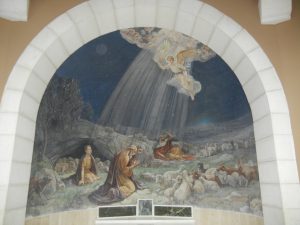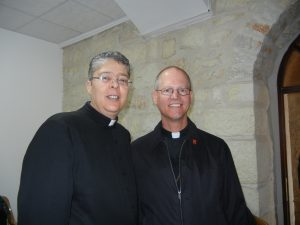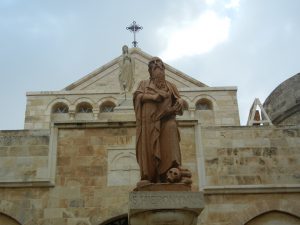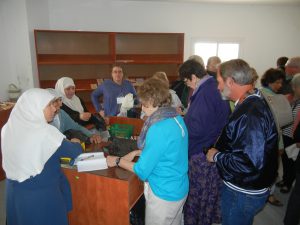Sunday, April 12, Holy Land
Bethlehem was a very small town at the time of Jesus. Translated, Bethlehem means “House of Bread.” In God’s eyes, this must be one of the reasons this humble town was chosen to be the birthplace of the Son of God, the Bread come down from heaven. Sloping away from Bethlehem there is a deep valley where the shepherd’s field lies below the town, and is where the angel appeared to the shepherds to announce to them the birth of our Lord.
“Now there were shepherds in that region living in the fields and keeping the night watch over their flock. The angel of the Lord appeared to them and the glory of the Lord shone around them, and they were struck with great fear. The angel said to them, ‘Do not be afraid; for behold, I proclaim to you good news of great joy that will be for all the people. For today in the city of David a savior has been born for you who is Messiah and Lord.’ … And suddenly there was a multitude of the heavenly host with the angel, praising God and saying: ‘Glory to God in the highest and on earth peace to those on whom his favor rests.’” (Luke 2:8-14)
Scattered throughout the field there are many caves. The shepherds used to bring their flocks into the back of these caves, and then keep watch at the entrance. It is also in one such cave that the Holy Family took shelter and gave birth to Jesus. It is over this site that the star shone and led the Magi to pay homage. A lovely church is built in this location with beautiful mosaics recalling the angel’s visit to the magi and their obedient response to visit the new born savior.
The star of Bethlehem has fourteen points, which represent the fourteen generations from Abraham to David; from David to the Babylonian exile, and fourteen generations from the Babylonian exile to the Messiah. (see Matthew 1:1-17)
There are three main criteria used to determine the authenticity of the sites of the Holy Land; written texts, including Sacred Scripture, oral tradition, and archeological findings. One of the archeological findings that led to the belief we have discovered the birth place of Jesus was in one of these many caves were found many bones and skulls of children, and among these bones were found other bones of adults. The belief is that the many children who died at the hands of Herod upon learning the news of the birth of Jesus (Matthew 2:16) were later buried near his birthplace.
Sunday morning, our group traveled from Bethlehem a short distance to another town of Beit Jala, to the parish church of the Annunciation. There, the pastor, Fr. Aktham Hijazin welcomed us to join the parish 10:00 Mass. This was Divine Mercy Sunday. The parishioners here are the descendants of the Palestinian Christians of Jesus’ time. Many people do not realize that there are Arab Christians today, who are not converts, but were born Christian, and trace their faith roots back to the time of Christ. These Palestinian Christians face great struggles here in Israel today, and it was a great privilege to celebrate Mass with them. We were happy to tell them that part of our pilgrimage was to be here with them in support and solidarity.
Church of St. Catherine of Alexandria is adjacent to the Church of the Nativity. Beneath the church are grottos where St. Jerome lived for many years. It is in this location that St. Jerome translated the bible into the Latin (vulgate.) St. Jerome is also buried in one of these grottos, not far from where we celebrated Mass.
The Church of the Nativity and the Church of St. Catherine are part of the same complex. Perhaps one of the most interesting parts of the design of the church is the door of entrance is very low and narrow. Practically, these doors were made so over the centuries of wars and conflict to prevent animals entry. On a more spiritual level, the door also requires one to humbly bow as they enter the sanctuary which preserves Christ’s birthplace. Here as in all the other major sites in Jerusalem, various faith communities share the space, such as the Greek Orthodox, Roman Catholics, Armenians, and so on.
On Monday, our pilgrimage traveled to Obeideyah, to see some of the work of our Catholic Relief Service. We met here a Palestinian woman, Hanan, and here daughter, Claudette. Hanan has worked for CRS for 26 years. She presently manages this project which helps Palestinian women practice a trade of making hand made crafts embroidered with Palestinian artwork. Three villages participate in this project and it presently serves 26 women. Many of the men are unemployed since the Palestinian villages are now cutoff from Jerusalem, unable to obtain permits to travel or work. So, these women are able to receive funds or vouchers for their work as a means of providing food and services for their families.
Catholic Relief Services has had a presence in Jerusalem since 1961, following the 1948 establishment of the Jewish State, and the devastating effects it continues to have on the Palestinian people. Today, there are 18 refugee camps for Palestinian across the West Bank and the Gaza Strip. Besides providing space and materials for women to earn a living in this project, CRS continues to provide training, water projects, infrastructure, agricultural projects, youth projects, fuel for hospitals and schools, and relief and recovery shelters following this summer’s war between Israel and the Palestinians.
Another stop today was Bethany, (House of the Poor), and this too is within the Palestinian territory. There is extreme poverty experienced here. As we were leaving, we came upon a car accident. The people here are left to provide for themselves. About twenty people had surrounded the cars to lift them up and separate them. There were no police, and no ambulances, no public services of any kind. So many men stand around idle all day due to the very high unemployment rate. These are very difficult realities to live with day in and day out.
We know from Scripture that Bethany was the home of Martha, Mary, and Lazarus and is only two miles from Jerusalem. Before the Security Wall, pilgrims used to be able to walk from Bethany to the Mount of Olives (as Jesus would have done in his time.) But now, people must drive around the wall which takes approximately 30 minutes to get back to Jerusalem.
The church here has no windows. It is built to resemble a tomb, and thus, recall the raising of Lazarus from the dead. (John 11) Again, there are some lovely mosaics depicting Jesus’ visit with Martha, Mary and Lazarus, and the miraculous event of raising the dead man to life.
0




